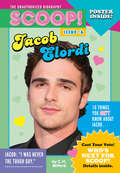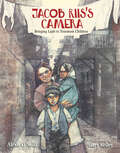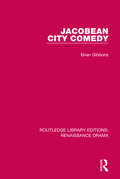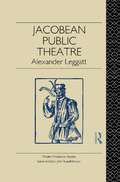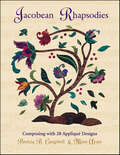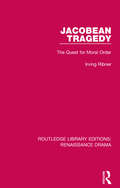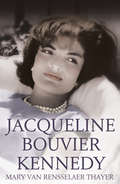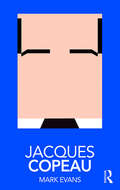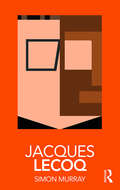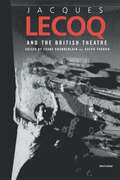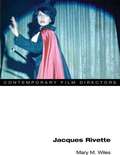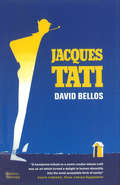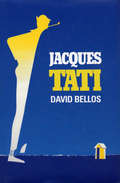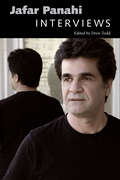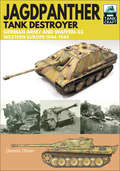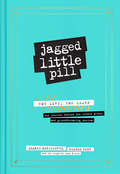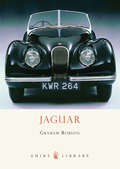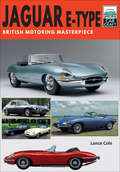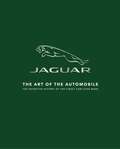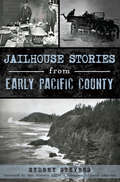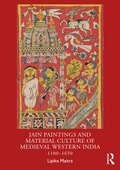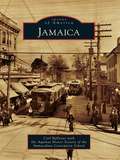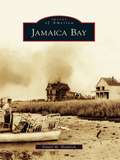- Table View
- List View
Jacob Elordi: Issue #6 (Scoop! The Unauthorized Biography #6)
by C. H. MitfordIntroducing a new series of unauthorized biographies on the world's biggest names and rising stars in entertainment, sports, and pop culture! Complete with quizzes, listicles, trivia, and a full-color pull-out poster of the star, this is the definitive collection to get the full Scoop! and more on your favorite celebrities.Jacob Elordi is on his way to superstar status:From his breakout role as Noah in The Kissing Booth to his steamy HBO debut in Euphoria followed by an ad campaign for Calvin Klein underwear, things are really starting to heat up for this Aussie actor. But what's next?Get the full Scoop! and more on Jacob Elordi, Hollywood's next heartthrob.
Jacob Riis's Camera: Bringing Light to Tenement Children
by Alexis O'NeillThis revealing biography of a pioneering photojournalist and social reformer Jacob Riis shows how he brought to light one of the worst social justice issues plaguing New York City in the late 1800s--the tenement housing crisis--using newly invented flash photography.Jacob Riis was familiar with poverty. He did his best to combat it in his hometown of Ribe, Denmark, and he experienced it when he immigrated to the United States in 1870. Jobs for immigrants were hard to get and keep, and Jacob often found himself penniless, sleeping on the streets or in filthy homeless shelters. When he became a journalist, Jacob couldn't stop seeing the poverty in the city around him. He began to photograph overcrowded tenement buildings and their impoverished residents, using newly developed flash powder to illuminate the constantly dark rooms to expose the unacceptable conditions. His photographs inspired the people of New York to take action. Gary Kelley's detailed illustrations perfectly accompany Alexis O'Neill's engaging text in this STEAM title for young readers.
Jacobean City Comedy (Routledge Library Editions: Renaissance Drama)
by Brian GibbonsThe first decade of the Jacobean age witnessed a sudden profusion of comedies satirizing city life; among these were comedies by Ben Jonson, John Marston and Thomas Middleton, as well as the bulk of the repertory of the newly-established children’s companies at Blackfriars and Paul’s. The playwrights self-consciously forged a new genre which attracted London audiences with its images of folly and vice in Court and City, and hack-writing dramatists were prompt to cash in on a new theatrical fashion. This study, first published in 1980, examines ways in which the Jacobean city comedy reflect on the self-consciousness of audiences and the concern of the dramatists with Jacobean society. This title will be of interest of students of Renaissance Drama, English Literature and Performance.
Jacobean Private Theatre (Routledge Library Editions: Renaissance Drama)
by Keith SturgessIn this scholarly and entertaining book, first published in 1987, the author tells the story of Jacobean private theatre. Most of the best plays written after 1610, including Shakespeare’s late plays such as The Tempest, were written for the new breed of private playhouses – small, roofed and designed for an aristocratic, literary audience, as opposed to the larger, open-air houses such as the Globe and the Red Bull, catering for a popular, ‘lowbrow’ audience. The author discusses the polarisation of taste and the effect it had on literary criticism and theatre history. This title will be of interest to students of English Literature, Drama and Performance.
Jacobean Public Theatre (Theatre Production Studies)
by Alexander LeggattJacobean Public Theatre recovers for the modern reader the acting, production and performance values of the public theatre of Jacobean London. It relates this drama to the popular culutre of the day and concludes with a close study of four important plays, including King Lear, which emerge in an unexpected light as the products of popular tradition.
Jacobean Rhapsodies: Composing with 28 Appliqué Designs
by Patricia B. Campbell Mimi AyarsPat uses exciting contemporary fabrics and glorious colors while maintaining the gracefulness and charm of this classic needlework style, also known as "crewel work." Presenting 28 unique appliqué designs, adapted from the Jacobean embroidery style, to embellish quilts, clothing, and home decor items. Enjoy these exquisite needlework designs of sweeping branches, graceful leaves, swirling vines, and exotic flowers. Includes 10 quilt projects and instructions for Pat's own appliqué method. The book offers help with choosing appropriate fabrics, as well as strategies for achieving beautiful color and contrast in appliqué work.
Jacobean Tragedy: The Quest for Moral Order (Routledge Library Editions: Renaissance Drama)
by Irving RibnerThe work of dramatists such as George Chapman, Thomas Heywood, Cyril Tourneur, John Webster, Thomas Middleton and John Ford can profitably be studied as attempts to construct a new moral order in response to the absence or weakening of the religious sanction. In this study, first published in 1962, the author examines these texts in detail, and throws a great deal of light on the plays as plays. This title will be of interest to students of English Literature, Drama and Performance.
Jacqueline Bouvier Kennedy
by Mary Van Rensselaer ThayerJacqueline Bouvier Kennedy, first published in 1961, is biography of the first-lady, from her early childhood to her meeting and marriage with John F. Kennedy. The book ends with the family’s move into the White House (and before the President’s tragic assassination in November 1963). Author Mary Rensselaer Thayer worked closely with Mrs. Kennedy to produce the book, and it is reported that Jacqueline prepared much of the initial draft. Included are 35 pages of illustrations.
Jacques Copeau (Routledge Performance Practitioners)
by Mark EvansThis book examines Jacques Copeau, a leading figure in the development of twentieth-century theatre practice, a pioneer in actor-training, physical theatre and ensemble acting, and a key innovator in the movement to de-centralize theatre and culture to the regions. Noe reissued, Jacques Copeau combines: an overview of Copeau's life and work an analysis of his key ideas a detailed commentary of his 1917 production of Moliere's late farce Les Fourberies de Scapin – the opening performance of his influential New York season a series of practical exercises offering an introduction to Copeau's working methods. As a first step towards critical understanding, and as an initial exploration before going on to further, primary research, Routledge Performance Practitioners are unbeatable value for today's student.
Jacques Lecoq (Routledge Performance Practitioners)
by Simon MurrayThis volume offers a concise guide to the teaching and philosophy of one of the most significant figures in twentieth century actor training. Jacques Lecoq's influence on the theatre of the latter half of the twentieth century cannot be overestimated. Now reissued Jacques Lecoq is the first book to combine: an historical introduction to his life and the context in which he worked an analysis of his teaching methods and principles of body work, movement, creativity, and contemporary theatre detailed studies of the work of Theatre de Complicite and Mummenschanz practical exercises demonstrating Lecoq's distinctive approach to actor training.
Jacques Lecoq and the British Theatre
by Franc Chamberlain Ralph YarrowJacques Lecoq and the British Theatre brings together the first collection of essays in English to focus on Lecoq's school of mime and physical theatre. For four decades, at his school in Paris, Jacques Lecoq trained performers from all over the world and effected a quiet evolution in the theatre. The work of such highly successful Lecoq graduates as Theatre de Complicite (The Winter's Tale with the Royal Shakespeare Company and The Visit, The Street of Crocodiles and The Causcasian Chalk Circle with the Royal National Theatre) has brought Lecoq's work to the attention of mainstream critics and audiences in Britain. Yet Complicte is just the tip of the Iceberg. The contributors to this volume, most of them engaged in applying Lecoq's work, chart some of the diverse ways in which it has had an impact on our conceptions of mime, physical theatre, actor training, devising street theatre and interculturalism. This lively - even provocative - collection of essays focuses academic debate and raises awareness of the impact of Lecoq's work in Britain today.
Jacques Rivette (Contemporary Film Directors)
by Mary M. WilesAs a pioneer of the French New Wave, Jacques Rivette was one of a group of directors who permanently altered the world's perception of cinema by taking the camera out of the studios and into the streets. His films, including Paris nous appartient, Out 1: Noli me tangere, Céline et Julie vont en bateau--Phantom Ladies Over Paris, La belle noiseuse, Secret défense, and Va savoir are extraordinary combinations of intellectual depth, playfulness, and sensuous beauty. In this study of Rivette, Mary M. Wiles provides a thorough account of the director's career from the burgeoning French New Wave to the present day, focusing on the theatricality of Rivette's films and his explorations of the relationship between cinema and fine arts such as painting, literature, music, and dance. Wiles also explores the intellectual interests that shaped Rivette's approach to film, including Sartre's existentialism, Barthes's structuralism, and the radical theater of the 1960s. The volume concludes with Wiles's insightful interview with Rivette.
Jacques Tati
by David BellosThe full story of one of France's greatest cinema legends, a clown whose film-making innovation was to turn everyday life into an art form.Jacques Tati's Monsieur Hulot, unmistakable with his pipe, brolly and striped socks, was a creation of slapstick genius that made audiences around the world laugh at the sheer absurdity of life. This biography charts Tati's rise and fall, from his earliest beginnings as a music hall mime during the Depression, to the success of Jour de Fête and Mon Oncle, to Playtime, the grandiose masterpiece that left the once celebrated director bankrupt and begging for equipment to complete his final films. Analysing Tati's singular vision, Bellos reveals the intricate staging of his most famous gags and draws upon hitherto inaccessible archives to produce a unique assessment of his work and its context for film lovers and film students alike.
Jacques Tati His Life & Art
by David BellosJacques Tati's Monsieur Hulot, unmistakeable with his pipe, brolly and striped socks, was a creation of sheer slapstick genius that made audiences around the world laugh at the sheer absurdity of life. This biography charts Tati's rise and fall, from his earliest beginnings as a music hall mime during the Depression, to the success of Jour de Fete and Mon Oncle, to Playtime, the grandiose masterpiece that left the once delebrated director bankrupt and begging for equipment to complete his final films. Analysing Tati's singular vision, Bellos reveals the intricate staging of his most famous gags and draws upon hitherto inaccessible archives to produce a unique assessment of his work and its context for film lovers and film students alike.
Jafar Panahi: Interviews (Conversations with Filmmakers Series)
by Drew ToddIranian filmmaker Jafar Panahi (b. 1960) is as famous for his remarkable films as for his courageous defiance of Iran’s state censorship. Panahi achieved international recognition with his feature film debut, The White Balloon, the first Iranian film to receive an award at the Cannes Film Festival. His subsequent films—The Mirror, The Circle, and Offside—continue to receive acclaim throughout the world, yet they remain largely unseen in his own country due to years of conflict with the Iranian government. In spite of multiple arrests, a brief imprisonment, and a ban on making movies and giving interviews, Panahi speaks openly and passionately in this unique, invaluable collection of twenty-five interviews, open letters, and his own court statement, in which he makes a compelling case for artistic freedom and humanism. Many of these documents have been translated from Persian and appear in English for the first time, including an interview done exclusively for this volume. In sparkling, lively interviews, Panahi reveals his influences, politics, and filmmaking practices. He explains the challenges he faces while working within (and often around) Iran’s heavily restricted film industry, providing the reader a unique vantage point from which to consider Iranian cinema and society.
Jagdpanther Tank Destroyer: German Army and Waffen-SS, Western Europe, 1944–1945 (TankCraft)
by Dennis Oliver&“First class illustration and a very effective text overview . . . covers the development, on the Panther chassis, of a very effective tank destroyer.&”— Firetrench Combining the destructive firepower of the 88mm gun with the outstanding mobility of the Panther series, the Jagdpanther is quite probably the best-known tank destroyer of the Second World War. In the vehicle&’s first action on 30 July 1944, three Jagdpanthers managed to destroy eleven British tanks in a vicious two-minute fire fight near the village of Les Loges in Normandy, cementing the Jagdpanther&’s reputation as a potent tank killer. In his fifth book in the TankCraft series, Dennis Oliver uses contemporary photographs and meticulously researched, superbly presented color and monochrome illustrations to tell the story of these heavy self-propelled antitank guns and the units which operated them in the German defense of the Western Front. As with all the books in the TankCraft series, a large part of this work showcases available model kits and aftermarket products, complemented by a gallery of expertly constructed and painted models. Technical details as well as modifications introduced during production and in the field are also explained giving the modeler all the information and knowledge required. &“Really interesting concept to combine historical, technical and modeling content in one book. Nicely illustrated . . . As a first Jagdpanther book for modelers seeking an economical source on models, accessories and paint schemes, this is valuable… Highly Recommended for Beginner to Intermediate builders.&”—AMPS
Jagged Little Pill: Our New Musical - Vocal Selections (Piano-vocal-guitar Artist Songbook Ser.)
by Full CastThe official behind-the-scenes look at the powerful new musical based on Alanis Morissette's cult classic album Jagged Little Pill.Celebrating its 25-year anniversary in 2020, singer-songwriter Alanis Morissette's Grammy-Award winning album Jagged Little Pill has come to define a generation. In the "triumphant and moving" (Variety) Broadway musical of the same name, Morissette's iconic numbers -- including smash hits like "Ironic," "You Oughta Know," and "Hand in My Pocket," -- are paired with new songs by the beloved musician and a powerful original story by Academy Award-winning writer Diablo Cody (Juno). Hailed as "urgent, wildly entertaining, and wickedly funny" (The Boston Globe) and "joyful and redemptive, rousing and real" (The New York Times), the Jagged Little Pill musical is a poignant and emotionally revelatory experience that is speaking to audiences across generations. Now, for the first time, this book will take you behind the scenes with stunning photography, original in-depth interviews with the cast, crew, Alanis Morissette, and Diablo Cody, and an introduction from Morissette herself on the album's genesis and journey from release to acclaimed musical -- including details and anecdotes on her collaboration on the show. Including the full annotated libretto and a retrospective look at Alanis's artistic influences and the significance of the album within the cultural context of the 90s as well as its long-term impact on the music world as we know it, this beautifully rendered book is a must-have keepsake for anyone who has been touched by this production or Morissette's music.
Jaguar
by Graham RobsonSir William Lyons enjoyed a seemingly unstoppable rise to fame and fortune in the motor industry, and the Jaguar brand which he introduced became world-famous. Yet it did not happen overnight. In the 1920s he was in Blackpool, styling motorcycle sidecars, in the 1930s he was in Coventry developing the SS motor car, and the stand-alone Jaguar company did not appear until 1945. Until 1972, when he retired from business, Sir William was the mainstream, the chairman, the chief stylist, and the inspiration of all things Jaguar.Helped along by the amazing new XK engine of 1948, by motor racing success at Le Mans, and by the stunning style of cars like the XK120, the Mk 2 saloons and the extraordinary E-Type, Jaguar soon became world-famous. Along the way the company absorbed Daimler and Coventry-Climax, then merged voluntarily with BMC in 1966, and returned to Le Mans racing with great success in the 1980s.Although the company was later commercially buffeted by its involvement with British Leyland, with Ford and latterly with Land Rover, and finally the Indian conglomerate Tata which now controls the business, the company's products have always been stunning. Sports coupes which reach well beyond 150mph, sleek executive saloons with unbeatable styling, and the promise of much innovation in the next few years make this a story whose climax is yet to come.
Jaguar E-Type: British Motoring Masterpiece (Car Craft)
by Lance ColeThe author of Classic Car Gallery &“covers the Jaguar and its various incarnations with lovingly snappy prose . . . to excite the passions of Jaguar-mania&” (The Historical Miniatures Gaming Society). The third book in the new CarCraft series, Jaguar E-Type, frames the legend of what many call the world&’s most beautiful car design. Sir William Lyons and Malcolm Sayer carved automotive history with this car across its 1960s-1970s incarnations from roadster to coupé amid the fitting of Straight-Six, to V12 engines. With its new definition of sculptural styling, performance, handling and innovative style, the E-Type or XKE series in the USA, created a car of global impact that remains a great classic of all time. Here, experienced automotive writer, and industrial designer, Lance Cole pays tribute to the car in a detailed yet engaging commentary. New photography, the design story, and full coverage of the modeling options in synthetic materials and die cast metals, create a narrative of vital interest.The aim of the innovative CarCraft series is to provide modelmakers and car enthusiasts with a new standard of primarily visual reference of both full-size cars and their scale models. Each book contains detailed technical information imparted through drawings and photographs while the meticulously researched full-color profiles provides a complete reference for paint schemes and markings. In addition, every volume of the CarCraft series features summaries of design histories and operational careers, and reviews of available kits. &“This book will be of great interest to modelers planning on doing a Jaguar model and also to car enthusiasts.&”—AMPS Indianapolis
Jaguar: The Art of the Automobile
by Zef Enault Nicolas HeidetCreated in collaboration with Jaguar, this stunning book is the definitive story of its legendary cars. Jaguar: The Art of the Automobile is a journey through 100 years of beautiful cars - an essential companion for any fan and the perfect gift.With unprecedented access to material from the Jaguar archive, the book tells the story of the marque's cars through the years, from the earliest models and much-loved classics to the most recent machines. Features include: Entries on each of the greatest Jaguar models Stunning photography throughout - including never-before-seen images Detailed technical information The full story of the creation of the most legendary models Other treasures from the Jaguar archives With insightful, thoroughly-researched text, Jaguar: The Art of the Automobile is the ultimate history of an enduring icon, told through its greatest machines.
Jaguar: The Art of the Automobile
by Zef Enault Nicolas HeidetCreated in collaboration with Jaguar, this stunning book is the definitive story of its legendary cars.Jaguar: The Art of the Automobile is a journey through 100 years of beautiful cars - an essential companion for any fan and the perfect gift.With unprecedented access to material from the Jaguar archive, the book tells the story of the marque's cars through the years, from the earliest models and much-loved classics to the most recent machines. Features include: Entries on each of the greatest Jaguar models Stunning photography throughout - including never-before-seen images Detailed technical information The full story of the creation of the most legendary models Other treasures from the Jaguar archivesWith insightful, thoroughly-researched text, Jaguar: The Art of the Automobile is the ultimate history of an enduring icon, told through its greatest machines.
Jailhouse Stories from Early Pacific County (True Crime)
by Sydney Stevens Matt WintersHangings, lynchings and jail breaks are long forgotten in Pacific County, where tourists flock to quaint attractions every season. But back in the early days, when the first jailhouse was built, this was a rough, rustic setting. Popular cannery worker Lum You was hanged here in 1902--the only legal execution in county history. Industrious smugglers and creative entrepreneurs outwitted state-sanctioned prohibition measures, though some still did time in the jailhouse. Historian Sydney Stevens presents a collection of tales culled from a forgotten prison record book. Opium fiends, thieves, military deserters and even wayward girls jailed for incorrigible acts are brought out of the shadows of a wilderness long gone.
Jain Paintings and Material Culture of Medieval Western India: 1100–1650
by Lipika MaitraThrough a curated collection of key Jain paintings, this volume offers a glimpse into the way people lived in western India during the medieval times: What they wore, how they ornamented themselves, what they amused themselves with, what furniture they sat on, which modes of transport they used. It includes Jain paintings from various collections in India and abroad to underscore the value of pictorial evidence in piecing together the past. The book takes the reader on a breath-taking visual journey through the varied costumes, exquisite textiles, handcrafted ornaments, curiously shaped vessels and containers, musical instruments, arms and armour, conveyances, and many such articles of everyday use. These articles of everyday use are corroborated with the descriptions left by foreign travellers passing through western India at that time. It explores contemporary lexicons and vernacular literature from this period, for possible names in vogue for the articles of Material Culture. The work is richly illustrated with line drawings by the author to highlight the objects being referred to. What comes across clearly through this book is that art is the mirror of the times, and as such, paintings reflect the society in which they are created. A magnificent read, this book will be essential for scholars and researchers of Indian painting, art history, Indian art, arts and aesthetics, Jainism, visual arts, South Asian history, Indian history, heritage studies and cultural history. It will also be a must-have for history and visual arts enthusiasts all over the world.
Jamaica (Images of America)
by Carl Ballenas Aquinas Honor Society of the Immaculate Conception SchoolJamaica, Queens, has long occupied a commanding position in the political, social, and industrial life of Queens County. Indigenous people created a trail, used by various tribes to trade furs and other goods, through the woods that later became Jamaica Avenue, the main street of the village. Jamaica was witness to the evolution of change, receiving a charter from Dutch governor Peter Stuyvesant in 1656, becoming an English colony in 1664, and winning freedom in the American Revolution with the Jamaica Minutemen. The area is richly steeped in history: George Washington slept here; and Walt Whitman, Susan B. Anthony, Rufus King, Jacob Riis, and many more have left their mark on Jamaica. Jamaica is an astounding visual journey documenting the unique history of this remarkable community over more than 350 years.
Jamaica Bay (Images of America)
by Daniel M. HendrickFor more than two centuries after the Dutch settled its meandering shores, Jamaica Bay was little more than a watery expanse broken by small islands and a handful of mills. Rapid growth after the Civil War transformed the bay into a microcosm of a developing nation, as meadows gave way to houses and factories, and giant steamers and locomotives appeared. Plans to create the world's largest deepwater port here were never realized, yet Jamaica Bay did emerge as a hub for aviation; the first successful transatlantic flight departed over the bay-followed by millions of flights that have taken off from John F. Kennedy International Airport ever since. Through historic photographs, Jamaica Bay illustrates the bay's transformation into a shellfishing haven, a recreational playground with hotels and casinos, and now the focus of a longterm environmental rehabilitation.
